Beating of a Spherical Liquid Crystal Elastomer Balloon under Periodic Illumination
Abstract
:1. Introduction
2. Theoretical Model and Formulation
2.1. Dynamics of the Spherical LCE Balloon
2.2. Dynamic LCE Model
2.3. Nondimensionalization
2.4. Solution Method
3. Results and Discussion
3.1. Dimensionless Parameters
3.2. Optimal Illumination Period
3.3. Optimal Illumination Time Rate
3.4. Effect of Light Intensity
3.5. Effect of Contraction Coefficient
3.6. Effect of Amount of Substance
3.7. Effect of LCE Volume
3.8. Effect of Mass Density
3.9. Effect of External Pressure
3.10. Effect of Damping Coefficient
3.11. Effect of Initial Velocity
3.12. An Application Example of the Periodic Oscillation of the Balloon
4. Conclusions
Author Contributions
Funding
Institutional Review Board Statement
Informed Consent Statement
Data Availability Statement
Conflicts of Interest
References
- Dey, S.; Agra-Kooijman, D.M.; Ren, W.; McMullan, P.J.; Griffin, A.C.; Kumar, S. Soft elasticity in main chain liquid crystal elastomers. Crystals 2013, 3, 363–390. [Google Scholar] [CrossRef]
- Agrawal, A.; Yun, T.H.; Pesek, S.L.; Chapman, W.G.; Verduzco, R. Shape-responsive liquid crystal elastomer bilayers. Soft Matter 2014, 10, 1411–1415. [Google Scholar] [CrossRef] [PubMed]
- Camacho-Lopez, M.; Finkelmann, H.; Palffy-Muhoray, P.; Shelley, M. Fast liquid-crystal elastomer swims into the dark. Nat. Mater. 2004, 3, 307–310. [Google Scholar] [CrossRef] [PubMed]
- Jin, L.; Yan, Y.; Huo, Y. A gradient model of light-induced bending in photochromic liquid crystal elastomer and its nonlinear behaviors. Int. J. Nonlin. Mech. 2010, 45, 370–381. [Google Scholar] [CrossRef]
- Sawa, Y.; Urayama, K.; Takigawa, T.; DeSimone, A.; Teresi, L. Thermally driven giant bending of liquid crystal elastomer films with hybrid alignment. Macromolecules 2010, 43, 453–464. [Google Scholar] [CrossRef]
- Wang, Z.; Cai, S. Recent progress in programming liquid crystal elastomer through dynamic covalent chemistry. J. Mater. Chem. B. 2020, 8, 6610–6623. [Google Scholar] [CrossRef]
- Du, C.; Zhang, B.; Cheng, Q.; Xu, P.; Li, K. Thermally driven self-rotation of a hollow torus motor. Micromachines 2022, 13, 434. [Google Scholar] [CrossRef]
- Ware, T.H.; McConney, M.E.; Wie, J.J.; Tondiglia, V.P.; White, T.J. Voxelated liquid crystal elastomers. Science 2015, 347, 982–984. [Google Scholar] [CrossRef] [Green Version]
- Baumann, A.; Sánchez-Ferrer, A.; Jacomine, L.; Martinoty, P.; Houerou, V.L.; Ziebert, F.; Kulic, I.M. Motorizing fibres with geometric zero-energy modes. Nat. Mater. 2018, 17, 523–527. [Google Scholar] [CrossRef]
- Liu, J.; Gao, Y.; Wang, H.; Wang, H.; Poling-Skutvik, R.; Yang, S. Shaping and locomotion of soft robots using filament actuators made from liquid crystal elastomer–carbon nanotube composites. Adv. Intell. Syst. 2020, 2, 1900163. [Google Scholar] [CrossRef] [Green Version]
- Na, Y.H.; Aburaya, Y.; Orihara, H.; Hiraoka, K. Measurement of electrically induced shear strain in a chiral smectic liquid-crystal elastomer. Phys. Rev. E 2011, 83, 061709. [Google Scholar] [CrossRef] [PubMed] [Green Version]
- Vantomme, G.; Gelebart, A.H.; Broer, D.J.; Meijer, E.W. A four-blade light-driven plastic mill based on hydrazone liquid-crystal networks. Tetrahedron 2017, 73, 4963–4967. [Google Scholar] [CrossRef]
- Corbett, D.; Warner, M. Deformation and rotations of free nematic elastomers in response to electric fields. Soft Matter 2009, 5, 1433. [Google Scholar] [CrossRef]
- Hao, Z.; Wani, O.M.; Wasylczyk, P.; Kaczmarek, R.; Priimagi, A. Self-regulating iris based on light-actuated liquid crystal elastomer. Adv. Mater. 2017, 29, 1701814. [Google Scholar]
- Haberl, J.M.; Sanchez-Ferrer, A.; Mihut, A.M.; Dietsch, H.; Hirt, A.M.; Mezzenga, R. Liquid-crystalline elastomer-nanoparticle hybrids with reversible switch of magnetic memory. Adv. Mater. 2013, 25, 1787–1791. [Google Scholar] [CrossRef]
- Harris, K.D.; Bastiaansen, C.W.; Lub, J.; Broer, D.J. Self-assembled polymer films for controlled agent-driven motion. Nano. Lett. 2005, 5, 1857–1860. [Google Scholar] [CrossRef]
- Su, H.; Yan, H.; Zhong, Z. Deep neural networks for large deformation of photo-thermo-pH responsive cationic gels. Appl. Math. Model. 2021, 100, 549–563. [Google Scholar] [CrossRef]
- Küupfer, J.; Finkelmann, H. Liquid crystal elastomer: Influence of the orientational distribution of the crosslinks on the phase behaviour and reorientation process. Macromol. Chem. Phys. 1994, 195, 1353–1367. [Google Scholar] [CrossRef]
- Kai, L.; Wu, P.; Cai, S. Chemomechanical oscillations in a responsive gel induced by an autocatalytic reaction. J. Appl. Phys. 2014, 116, 6379–6380. [Google Scholar]
- Chihyung, A.; Li, K.; Cai, S. Light or thermally powered autonomous rolling of an elastomer rod. ACS Appl. Mater. Inter. 2018, 10, 25689–25696. [Google Scholar]
- Li, M.H.; Keller, P. Artificial muscles based on liquid crystal elastomers philos. Trans. R. Soc. A 2006, 364, 2763–2777. [Google Scholar]
- Lu, H.; Zou, Z.; Wu, X.; Shi, C.; Liu, Y.; Xiao, J. Biomimetic prosthetic hand enabled by liquid crystal elastomer tendons. Micromachines 2021, 12, 736. [Google Scholar] [CrossRef] [PubMed]
- Shenoy, D.K.; Thomsen, D.L., III; Srinivasan, A.; Keller, P.; Ratna, B.R. Carbon coated liquid crystal elastomer film for artificial muscle applications. Sensor. Actuat. A-Phys. 2002, 96, 184–188. [Google Scholar] [CrossRef]
- Fleischmann, E.K.; Liang, H.L.; Kapernaum, N.; Giesselmann, F.; Lagerwall, J.; Zentel, R. One-piece micropumps from liquid crystalline core-shell particles. Nat. Commun. 2012, 3, 1178. [Google Scholar] [CrossRef] [PubMed] [Green Version]
- Du, C.; Cheng, Q.; Li, K.; Yu, Y. Self-sustained collective motion of two joint liquid crystal elastomer spring oscillator powered by steady illumination. Micromachines 2022, 13, 271. [Google Scholar] [CrossRef] [PubMed]
- Zhao, D.; Liu, Y. Light-induced spontaneous bending of a simply supported liquid crystal elastomer rectangular plate. Phys. Rev. E 2020, 101, 042701. [Google Scholar] [CrossRef] [PubMed]
- Zhao, D.; Liu, Y. A prototype for light-electric harvester based on light sensitive liquid crystal elastomer cantilever. Energy 2020, 198, 117351. [Google Scholar] [CrossRef]
- Ohm, C.; Brehmer, M.; Zentel, R. Liquid crystalline elastomers as actuators and sensors. Adv. Mater. 2010, 22, 3366–3387. [Google Scholar] [CrossRef]
- Lin, G.R.; Lin, C.J.; Lin, C.T. Investigations on an integrated conducting nanoparticle–liquid crystal elastomerlayer. Nanotechnology 2007, 18, 415706–415711. [Google Scholar]
- Fan, H.; Li, S. Modeling microtubule cytoskeleton via an active liquid crystal elastomer model. Comp. Mater. Sci. 2015, 96, 559–566. [Google Scholar] [CrossRef]
- Xia, Y.; Cedillo-Servin, G.; Kamien, R.D.; Yang, S. Guided folding of nematic liquid crystal elastomer sheets into 3D via patterned 1D microchannels. Adv. Mater. 2016, 28, 9637–9643. [Google Scholar] [CrossRef] [PubMed]
- Dawson, N.J.; Kuzyk, M.G.; Neal, J.; Luchette, P.; Palffy-Muhoray, P. Modeling the mechanisms of the photomechanical response of a nematic liquid crystal elastomer. Josa. B 2011, 28, 2134–2141. [Google Scholar] [CrossRef] [Green Version]
- Lindsey, H.; Kirstin, P.; Guo, Z.L.; Metin, S. Soft actuators for small-scale robotics. Adv. Mater. 2017, 29, 1603483. [Google Scholar]
- Li, C.; Liu, Y.; Huang, X.; Jiang, H. Direct sun-driven artificial heliotropism for solarenergy harvesting based on a photo-thermomechanical liquid-crystal elastomer nanocomposite. Adv. Funct. Mater. 2012, 22, 5166–5174. [Google Scholar] [CrossRef]
- Li, K.; Du, C.; He, Q.; Cai, S. Thermally driven self-oscillation of an elastomer fiber with a hanging weight. Extreme. Mech. Lett. 2021, 50, 101547. [Google Scholar] [CrossRef]
- Minori, A.F.; He, Q.; Glick, P.E.; Adibnazari, I.; Stopol, A.; Cai, S.; Tolley, M.T. Reversible actuation for self-folding modular machines using liquid crystal elastomer. Smart. Mater. Struct. 2020, 29, 105003. [Google Scholar] [CrossRef]
- Turiv, T.; Krieger, J.; Babakhanova, G.; Yu, H.; Shiyanovskii, S.V.; Wei, Q.H.; Lavrentovich, O.D. Topology control of human fibroblast cells monolayer by liquid crystal elastomer. Sci. Adv. 2020, 6, eaaz6485. [Google Scholar] [CrossRef]
- Dawson, N.J.; Kuzyk, M.G.; Neal, J.; Luchette, P.; Palffy-Muhoray, P. Cascading of liquid crystal elastomer photomechanical optical devices. Opt. Commun. 2011, 284, 991–993. [Google Scholar] [CrossRef] [Green Version]
- Wu, J.; Ye, W.; Wang, Y.; Su, C.Y. Modeling of photo-responsive liquid crystal elastomer actuators. Inform. Sci. 2021, 560, 441–455. [Google Scholar] [CrossRef]
- Firouzi, B.; Zamanian, M. The effect of capillary and intermolecular forces on instability of the electrostatically actuated microbeam with t-shaped paddle in the presence of fringing field. Appl. Math. Model. 2019, 71, 243–268. [Google Scholar] [CrossRef]
- Karimipour, I.; Beni, Y.T.; Akbarzadeh, A.H. Size-dependent nonlinear forced vibration and dynamic stability of electrically actuated micro-plates. Commun. Nonlinear. Sci. 2019, 78, 104856. [Google Scholar] [CrossRef]
- Montazami, R.; Spillmann, C.M.; Naciri, J.; Ratna, B.R. Enhanced thermomechanical properties of a nematic liquid crystal elastomer doped with gold nanoparticles. Sensor. Actuat. A-Phys. 2012, 178, 175–178. [Google Scholar] [CrossRef]
- Zhang, J.; Guo, Y.; Hu, W.; Soon, R.H.; Davidson, Z.S.; Sitti, M. Smart actuators: Liquid crystal elastomer-based magnetic composite films for reconfigurable shape-morphing soft miniature machines. Adv. Mater. 2021, 33, 2170054. [Google Scholar] [CrossRef]
- Dunn, M.L. Photomechanics of mono- and polydomain liquid crystal elastomer films. J. Appl. Phys. 2007, 102, 013506. [Google Scholar] [CrossRef]
- Bhattacharyya, A.; Smith, T.L.; Anderson, A.C. Low temperature thermal conductivity and specific heat of elastomers. J. Non-Cryst. Solids. 1979, 31, 395–400. [Google Scholar] [CrossRef]
- Jiang, W.; Niu, D.; Liu, H.; Wang, C.; Zhao, T.; Yin, L.; Shi, Y.; Chen, B.; Ding, Y.; Lu, B. Photoresponsive soft-robotic platform: Biomimetic fabrication and remote actuation. Adv. Funct. Mater. 2014, 24, 7598–7604. [Google Scholar] [CrossRef]
- Chambers, M.; Finkelmann, H.; Remškar, M.; Sánchez-Ferrer, A.; Zalar, B.; Žumer, S. Liquid crystal elastomer–nanoparticle systems for actuation. J. Mate. Chem. 2009, 19, 1524–1531. [Google Scholar] [CrossRef]
- Fuchi, K.; Ware, T.H.; Buskohl, P.R.; Reich, G.W.; Vaia, R.A.; White, T.J.; Joo, J.J. Topology optimization for the design of folding liquid crystal elastomer actuators. Soft Matter 2015, 11, 7288–7295. [Google Scholar] [CrossRef]
- Kuenstler, A.S.; Chen, Y.; Bui, P. Blueprinting photothermal shape morphing of liquid crystal elastomers. Adv. Mater. 2020, 32, 2000609. [Google Scholar] [CrossRef]
- Choi, H.J.; Jeong, K.U.; Chien, L.C.; Lee, M.H. Photochromic 3-dimensional actuator based on an uncrosslinked liquid crystal elastomer. J. Mater. Chem. 2009, 19, 7124. [Google Scholar] [CrossRef]
- Desimone, A.; Gidoni, P.; Noselli, G. Liquid crystal elastomer strips as soft crawlers. J. Mech. Phys. Solids. 2015, 84, 254–272. [Google Scholar] [CrossRef] [Green Version]
- Cheng, Q.; Liang, X.; Li, K. Light-powered self-excited motion of a liquid crystal elastomer rotator. Nonlinear. Dynam. 2021, 103, 2437–2449. [Google Scholar] [CrossRef]
- Parrany, M.A. Nonlinear light-induced vibration behavior of liquid crystal elastomer beam. Int. J. Mech. Sci. 2018, 136, 179–187. [Google Scholar] [CrossRef]
- Li, M.E.; Lv, S.; Zhou, J.X. Photo-thermo-mechanically actuated bending and snapping kinetics of liquid crystal elastomer cantilever. Smart. Mate. Struct. 2014, 23, 125012–125018. [Google Scholar] [CrossRef]
- Schüring, H.; Stannarius, R.; Tolksdorf, C.; Zentel, R. Liquid crystal elastomer balloons. Macromolecules 2001, 34, 3962–3972. [Google Scholar] [CrossRef]
- Wang, Y.; Liao, W.; Sun, J.; Nandi, R.; Yang, Z. Bioinspired construction of artificial cardiac muscles based on liquid crystal elastomer fibers. Adv. Mater. 2021, 7, 2100934. [Google Scholar] [CrossRef]
- Yusuf, Y.; Sumisaki, Y.; Kai, S. Birefringence measurement of liquid single crystal elastomer swollen with low molecular weight liquid crystal. Chem. Phys. Lett. 2003, 382, 198–202. [Google Scholar] [CrossRef]
- Li, K.; Cai, S. Modeling of light-driven bending vibration of a liquid crystal elastomer beam. J. Appl. Mech. 2015, 83, 031009. [Google Scholar] [CrossRef] [Green Version]
- Chen, J.; Akomolafe, O.I.; Jiang, J.; Peng, C. Light-actuated liquid crystal elastomer prepared by projection display. Materials 2021, 14, 7245. [Google Scholar] [CrossRef]
- Dunn, M.L.; Maute, K. Photomechanics of blanket and patterned liquid crystal elastomer films. Mech. Mater. 2009, 41, 1083–1089. [Google Scholar] [CrossRef]
- Zhao, J.; Xu, P.; Yu, Y.; Li, K. Controllable vibration of liquid crystal elastomer beams under periodic illumination. Int. J. Mech. Sci. 2020, 170, 105366. [Google Scholar] [CrossRef]
- Cheng, Q.; Zhou, L.; Du, C.; Li, K. A light-fueled self-oscillating liquid crystal elastomer balloon with self-shading effect. Chaos. Soliton. Fract. 2022, 155, 111646. [Google Scholar] [CrossRef]
- Yu, Y.; Nakano, M.; Ikeda, T. Directed bending of a polymer film by light. Nature 2003, 425, 145. [Google Scholar] [CrossRef] [PubMed]
- Nägele, T.; Hoche, R.; Zinth, W.; Wachtveitl, J. Femtosecond photoisomerization of cis-azobenzene. Chem. Phys. Lett. 1997, 272, 489–495. [Google Scholar] [CrossRef]
- White, T.J.; Tabiryan, N.V.; Serak, S.V.; Hrozhyk, U.A.; Tondiglia, V.P.; Koerner, H.; Bunning, T. A high frequency photodriven polymer oscillator. Soft Matter 2008, 4, 1796–1798. [Google Scholar] [CrossRef]

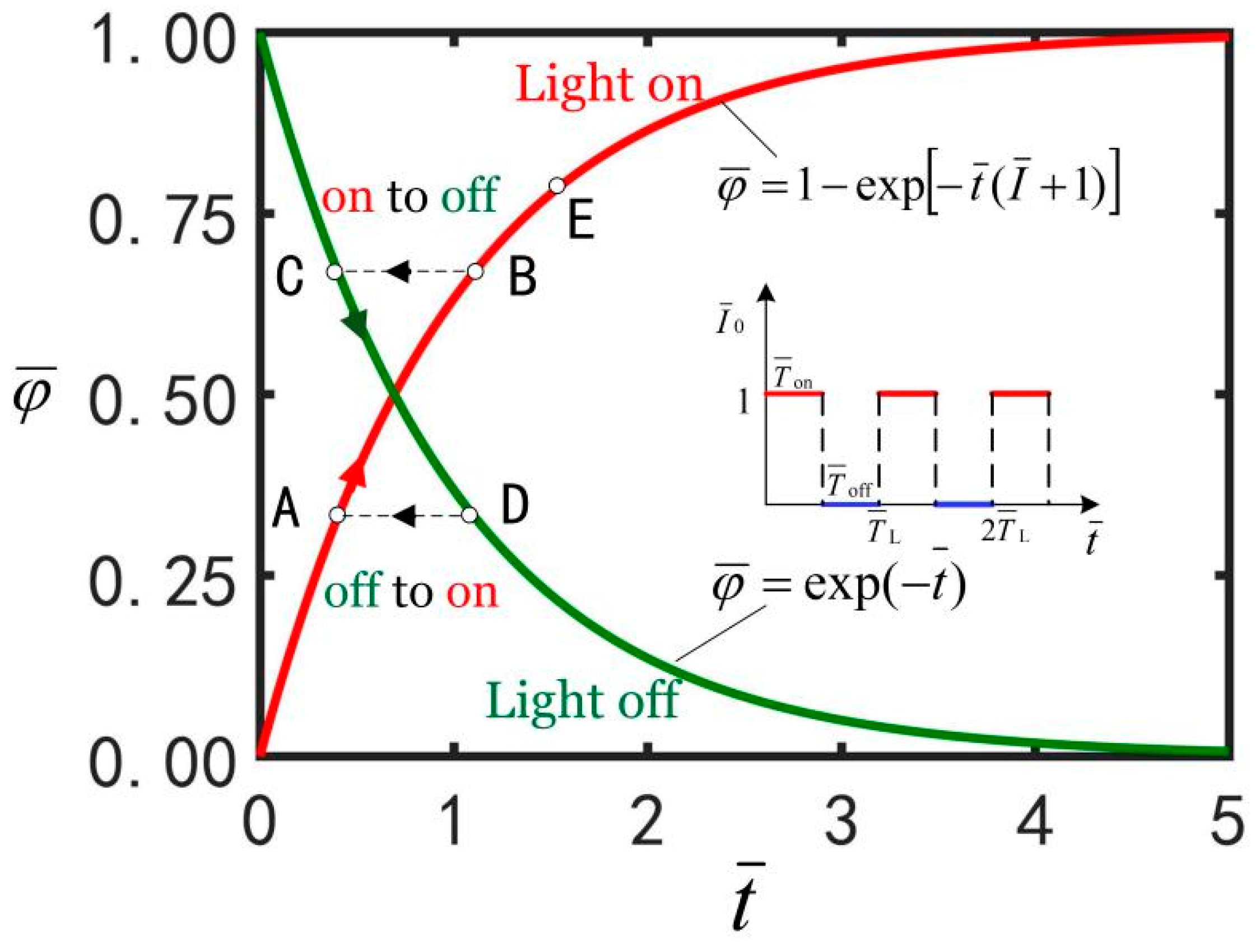
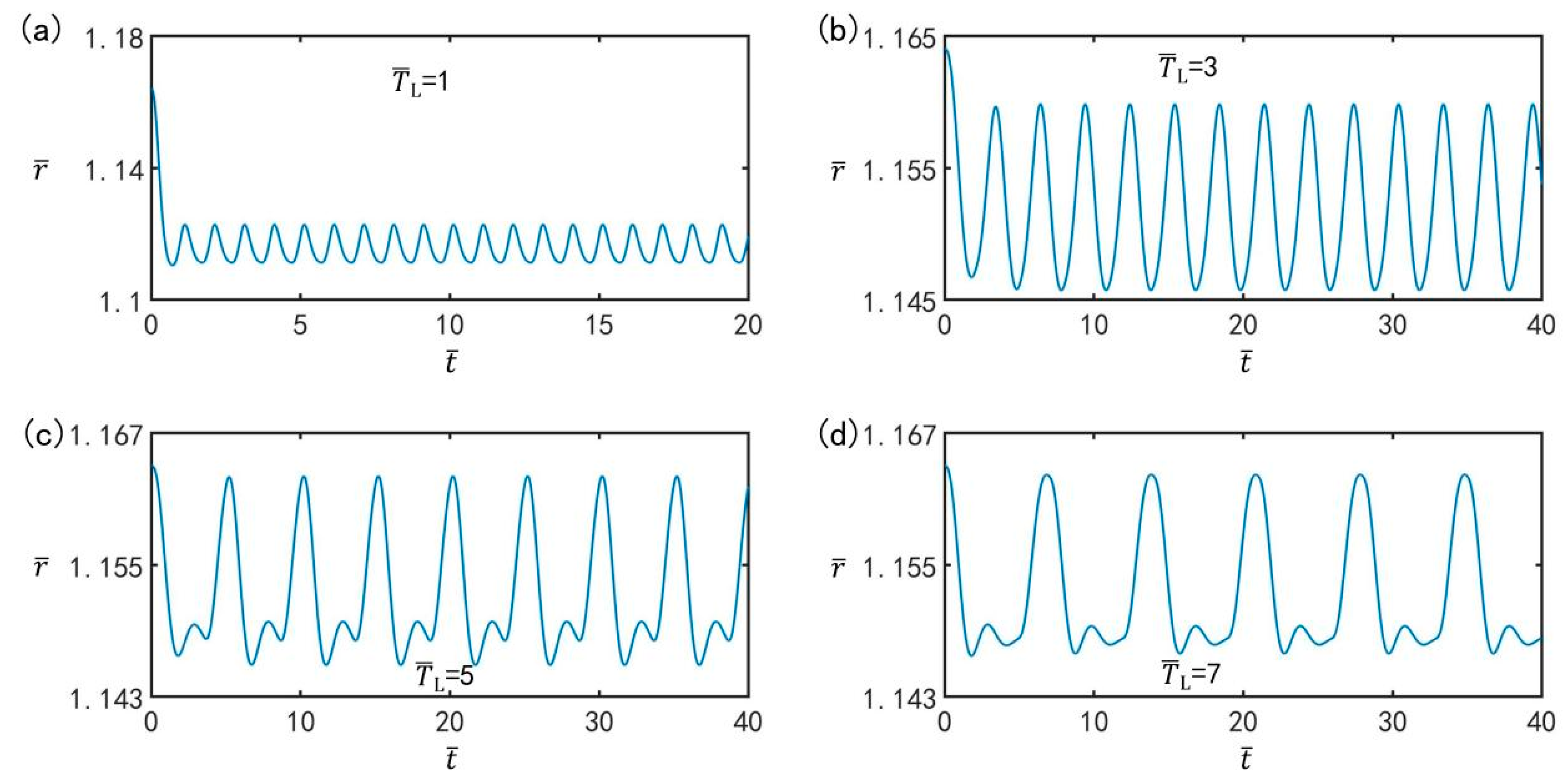



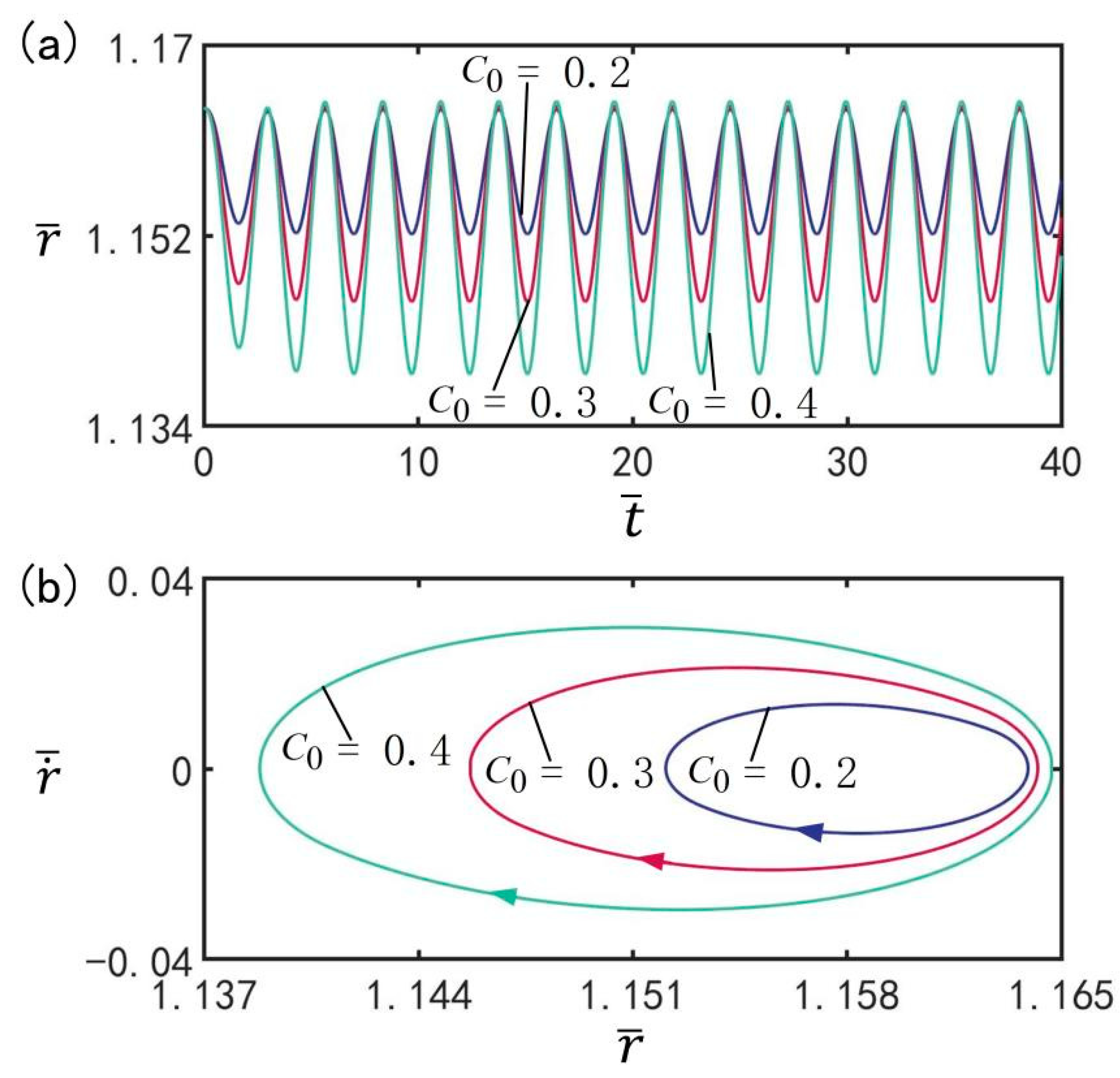
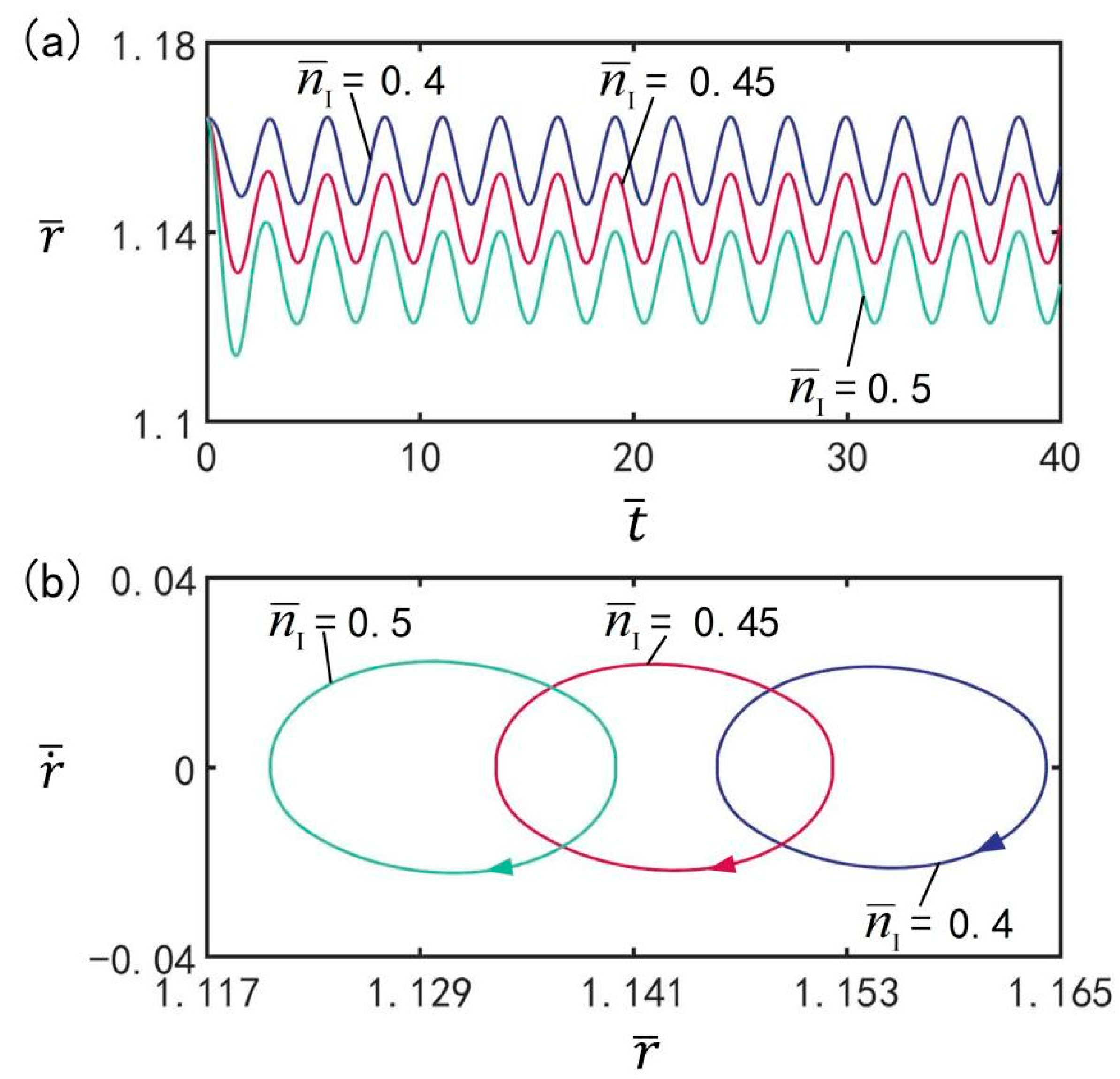



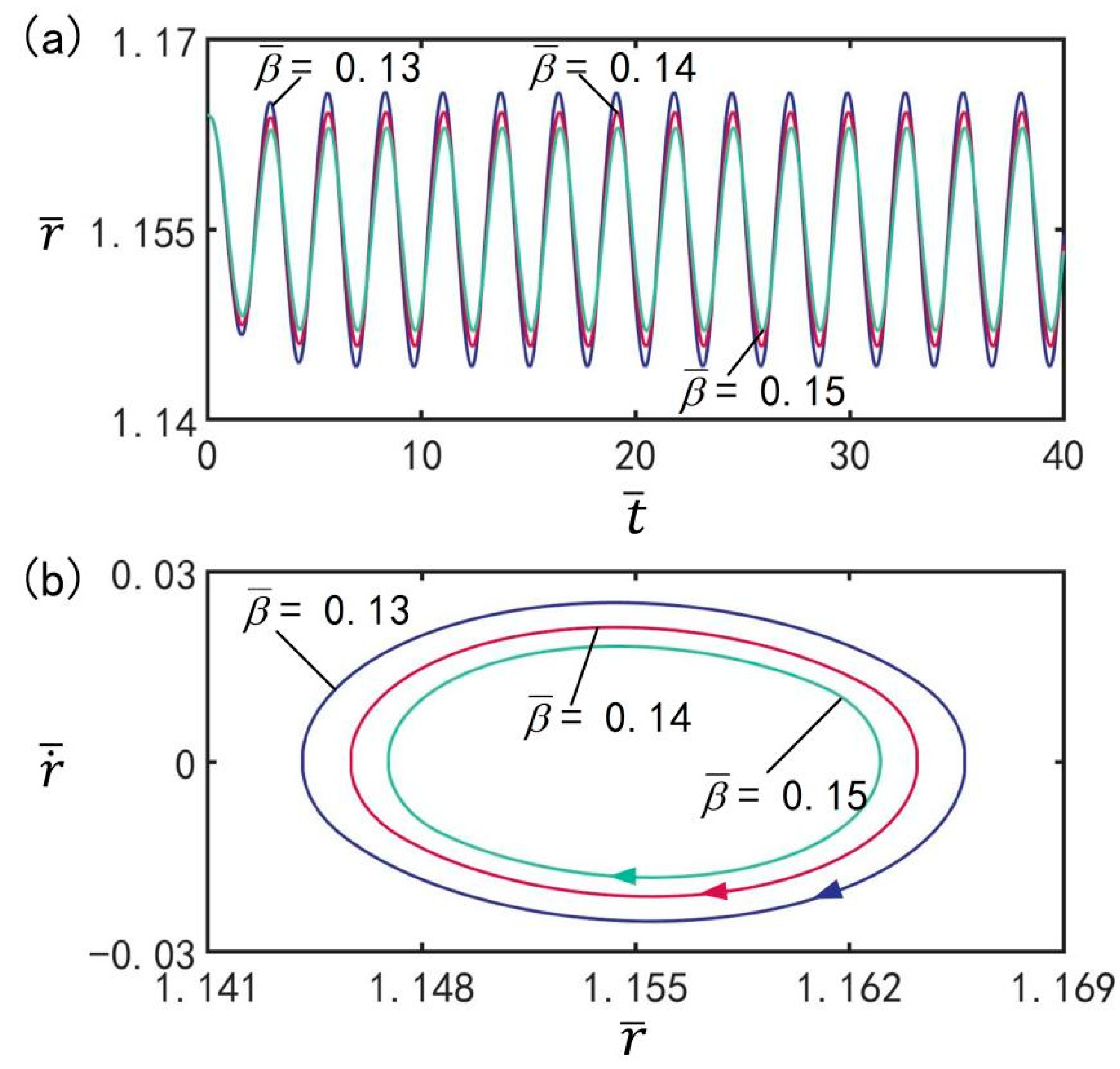

| Parameter | Definition | Value | Units |
|---|---|---|---|
| Thermal relaxation time | 0.1 | s | |
| Mass density | 1000~1200 | ||
| Light intensity | 15~35 | ||
| Damping coefficient | 8~10 | ||
| Light-absorption constant | 0.00022 | ||
| Young’s modulus | 1 | ||
| Initial radius | 0.001164 | m | |
| Contraction coefficient | 0.3 | / |
| 0.3~0.5 | 0.4~0.5 | 0.045~0.055 | 0.15~0.18 | 0.17~0.19 | 0.12~0.15 | 0~0.4 |
Publisher’s Note: MDPI stays neutral with regard to jurisdictional claims in published maps and institutional affiliations. |
© 2022 by the authors. Licensee MDPI, Basel, Switzerland. This article is an open access article distributed under the terms and conditions of the Creative Commons Attribution (CC BY) license (https://creativecommons.org/licenses/by/4.0/).
Share and Cite
Cheng, W.; Cheng, Q.; Du, C.; Dai, Y.; Li, K. Beating of a Spherical Liquid Crystal Elastomer Balloon under Periodic Illumination. Micromachines 2022, 13, 769. https://doi.org/10.3390/mi13050769
Cheng W, Cheng Q, Du C, Dai Y, Li K. Beating of a Spherical Liquid Crystal Elastomer Balloon under Periodic Illumination. Micromachines. 2022; 13(5):769. https://doi.org/10.3390/mi13050769
Chicago/Turabian StyleCheng, Wenyan, Quanbao Cheng, Changshen Du, Yuntong Dai, and Kai Li. 2022. "Beating of a Spherical Liquid Crystal Elastomer Balloon under Periodic Illumination" Micromachines 13, no. 5: 769. https://doi.org/10.3390/mi13050769
APA StyleCheng, W., Cheng, Q., Du, C., Dai, Y., & Li, K. (2022). Beating of a Spherical Liquid Crystal Elastomer Balloon under Periodic Illumination. Micromachines, 13(5), 769. https://doi.org/10.3390/mi13050769







